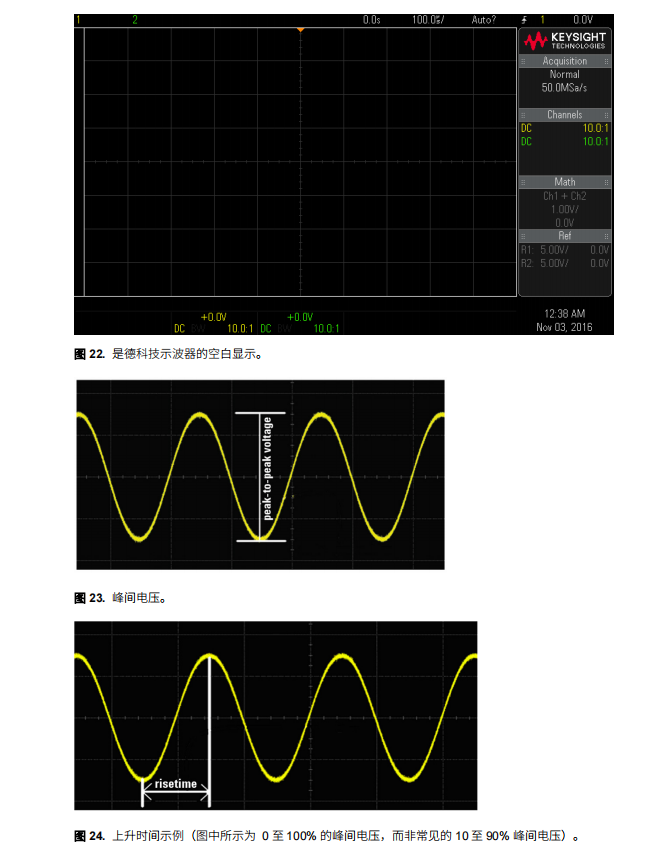What are the basic measurements commonly found on most oscilloscopes, and what are they?
Basic Measurements
A wide range of measurements can be performed on waveforms using a digital oscilloscope. The scope and complexity of the measurements depend on the oscilloscope's feature set. Figure 22 shows a blank display of a Keysight 8000 Series oscilloscope. Note the measurement buttons/icons listed on the far left side of the screen. These icons can be dragged onto the waveform using the mouse, and the measurement will be calculated. These icons are also convenient because the icons themselves tell you what measurement is being taken.
Peak-to-peak voltage: This measurement is used to calculate the voltage difference between the low and high voltages on a waveform cycle.
Voltage RMS :This measurement is used to calculate the voltage RMS value of the waveform. This quantity is then used to calculate the power.
Rise time: This measurement is used to calculate the time it takes for the signal to reach high voltage from low voltage. It is usually calculated by counting the time it takes to rise from 10% of the peak-to-peak voltage to 90% of the peak-to-peak voltage.
Pulse Width: The positive pulse width measurement calculates the pulse width by calculating the time it takes for the inter-peak voltage to rise from 50% to the maximum voltage and then fall back to the 50% mark. The negative pulse width measurement calculates the pulse width by calculating the time it takes for the waveform to drop from 50% of the peak-to-peak voltage to the minimum voltage and then back to the 50% mark.
Period: This measurement is used to calculate the period of the waveform.
Frequency: This measurement is used to calculate the frequency of the waveform. This list is intended to give you an idea of the types of measurements available on most oscilloscopes. However, there are many more measurements that can be performed on most oscilloscopes.
Basic Math Functions
In addition to the above measurements, you can perform many mathematical operations on waveforms. Examples of demonstrations include
Fourier Transform:Use this math function to see the frequencies that make up a signal.
Absolute value: This math function is used to display the absolute value of a waveform (in terms of voltage).
Integral:This math function is used to calculate the integral of a waveform.
Addition or Subtraction: These math functions can be used to add or subtract multiple waveforms and display the resulting signal. Again, these functions are only a small part of the measurement and math functions available on the oscilloscope
Basic Measurements
A wide range of measurements can be performed on waveforms using a digital oscilloscope. The scope and complexity of the measurements depend on the oscilloscope's feature set. Figure 22 shows a blank display of a Keysight 8000 Series oscilloscope. Note the measurement buttons/icons listed on the far left side of the screen. These icons can be dragged onto the waveform using the mouse, and the measurement will be calculated. These icons are also convenient because the icons themselves tell you what measurement is being taken.
Peak-to-peak voltage: This measurement is used to calculate the voltage difference between the low and high voltages on a waveform cycle.
Voltage RMS :This measurement is used to calculate the voltage RMS value of the waveform. This quantity is then used to calculate the power.
Rise time: This measurement is used to calculate the time it takes for the signal to reach high voltage from low voltage. It is usually calculated by counting the time it takes to rise from 10% of the peak-to-peak voltage to 90% of the peak-to-peak voltage.
Pulse Width: The positive pulse width measurement calculates the pulse width by calculating the time it takes for the inter-peak voltage to rise from 50% to the maximum voltage and then fall back to the 50% mark. The negative pulse width measurement calculates the pulse width by calculating the time it takes for the waveform to drop from 50% of the peak-to-peak voltage to the minimum voltage and then back to the 50% mark.
Period: This measurement is used to calculate the period of the waveform.
Frequency: This measurement is used to calculate the frequency of the waveform. This list is intended to give you an idea of the types of measurements available on most oscilloscopes. However, there are many more measurements that can be performed on most oscilloscopes.
Basic Math Functions
In addition to the above measurements, you can perform many mathematical operations on waveforms. Examples of demonstrations include
Fourier Transform:Use this math function to see the frequencies that make up a signal.
Absolute value: This math function is used to display the absolute value of a waveform (in terms of voltage).
Integral:This math function is used to calculate the integral of a waveform.
Addition or Subtraction: These math functions can be used to add or subtract multiple waveforms and display the resulting signal. Again, these functions are only a small part of the measurement and math functions available on the oscilloscope







